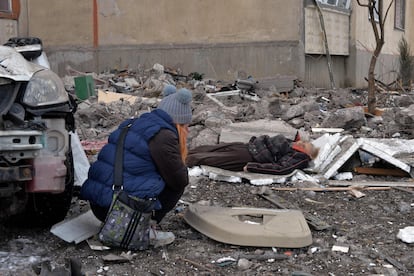The war of numbers between Russia and Ukraine: Why death tolls have become propaganda
The United Nations has confirmed the deaths of 406 Ukrainian civilians, but the real figure is likely to be much higher


The government of Ukraine on Sunday claimed that 11,000 Russian soldiers had been killed so far since the start of the invasion on February 24. That is 22 times higher than the figure recognized by the Kremlin, which has only acknowledged 498 deaths.
That was on March 2, and since then Moscow has admitted no more casualties. That same day, Ukrainian officials said that the Russian death toll was as high as 5,840. Neither version is anywhere near the tally kept by the United States, which has placed Russian losses in the first four days at somewhere between 1,500 and 2,000.
These wild variations, which also extend to the death toll among Ukrainian soldiers and civilians, underscore another type of battle that is going on for control over the war narrative.
“Propaganda is not only directed abroad, but also domestically at the civilian population keeping up the war effort and at the members of the armed forces who are carrying it out,” said Alejandro Pizarroso Quintero, a propaganda expert who teaches at Madrid’s Complutense University, in a recent article.
It is precisely these differences in military deaths that illustrate the story that each side wants to offer its own people. Ukraine, which claims to have killed 11,000 Russian soldiers while barely mentioning casualties in its own ranks, is encouraging the population with its tale of successful resistance. Russia, in the meantime, has only acknowledged a small number of deaths, while claiming that its troops have killed around 2,000 Ukrainian soldiers and saying nothing about civilian casualties. The main goal here is to get Russian public opinion to support the attack on the neighboring country ordered by President Vladimir Putin.
Verifying the figures is a hard job, especially during an armed conflict when access to combat zones for independent observers can very limited or altogether non-existent. According to the latest data released by the United Nations refugee agency UNHCR, between February 24 and March 6, the agency had recorded 1,207 civilian casualties in the country: 406 killed and 801 injured. The tally includes 42 more deaths and 42 more injuries than the previous UNHCR report, despite intensifying combat and Russian attacks on civilian areas. The Ukrainian government’s own latest update on March 2 was already talking about over 2,000 deaths.
The UN agency believes “that the real figures are considerably higher, especially in government-controlled territory and especially in recent days, as the receipt of information from some locations where intense hostilities have been going on has been delayed and many reports are still pending corroboration.”
Verifying casualties is a difficult process in the middle of a war, and in the best of cases, parties resort to estimates. It happened on February 28, when Russian troops began bombing the city of Kharkiv. The first reports cited a Facebook message posted by Anton Gerashchenko, an advisor to Ukraine’s Interior Ministry who stated that “dozens of people” had died in Russian missile attacks. This was picked up by dozens of international news outlets, even though the tally from that attack has since been widely accepted to be 10 fatalities.
The power of numbers
We live in a hypernumerical world concerned about quantification; therefore measuring something, or at least pretending to do so, announces its existence and underscores its importance and political relevance, according to Peter Andreas and Kelly M. Greenhill, editors of the book Sex, Drugs, and Body Counts: The Politics of Numbers in Global Crime and Conflict.
Numbers also have the power to give credibility to the individual using them, and to either encourage or restrict decision-making. Greenhill notes that former US president Bill Clinton seemed to base his support for the Iraq war on an erroneous and inflated assessment of the casualties in the Bosnian war (1992-1995) caused by a lack of decisive action by the West. In a speech in 2007, Clinton said that around 250,000 people had died in Bosnia and that a similar disaster had to be avoided in Iraq. According to Greenhill, the real death toll in Bosnia appears to be closer to 97,000, although the higher figure is still being used to this date.
Once a figure takes hold in the public imagination, particularly if it’s a very high one, it is difficult to get rid of it because of the power of numbers that Andreas and Greenhill were referring to. A classic example is a 1996 report by Unicef, the United Nations’ children’s agency, which said that “in the last decade, at least two million children have died in armed conflicts.” That number kept cropping up in print until recently, even though the period it alluded to was 1986 to 1996.
“Victim data is not just a collection of abstract numbers, they represent individual human beings,” said a source at UNHCR. Counting them correctly is “crucial” in order to later seek accountability and bring dignity to each of the victims.
Tu suscripción se está usando en otro dispositivo
¿Quieres añadir otro usuario a tu suscripción?
Si continúas leyendo en este dispositivo, no se podrá leer en el otro.
FlechaTu suscripción se está usando en otro dispositivo y solo puedes acceder a EL PAÍS desde un dispositivo a la vez.
Si quieres compartir tu cuenta, cambia tu suscripción a la modalidad Premium, así podrás añadir otro usuario. Cada uno accederá con su propia cuenta de email, lo que os permitirá personalizar vuestra experiencia en EL PAÍS.
¿Tienes una suscripción de empresa? Accede aquí para contratar más cuentas.
En el caso de no saber quién está usando tu cuenta, te recomendamos cambiar tu contraseña aquí.
Si decides continuar compartiendo tu cuenta, este mensaje se mostrará en tu dispositivo y en el de la otra persona que está usando tu cuenta de forma indefinida, afectando a tu experiencia de lectura. Puedes consultar aquí los términos y condiciones de la suscripción digital.
More information
Últimas noticias
There is as much life left to discover on planet Earth as that which is already known
Dozens presumed dead, around 100 injured in fire at Swiss Alps bar during New Year’s celebration
Is porn for women different from conventional porn? We spoke to those who make it
Cartagena de Indias is sinking: What can the city do to mitigate it?
Most viewed
- Reinhard Genzel, Nobel laureate in physics: ‘One-minute videos will never give you the truth’
- Sinaloa Cartel war is taking its toll on Los Chapitos
- David King, chemist: ‘There are scientists studying how to cool the planet; nobody should stop these experiments from happening’
- Oona Chaplin: ‘I told James Cameron that I was living in a treehouse and starting a permaculture project with a friend’
- The Interoceanic Train, the Mexican alternative to the Panama Canal










































